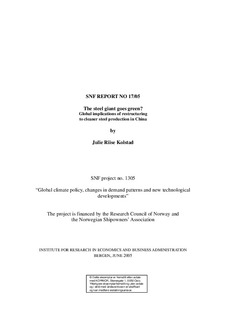| dc.contributor.author | Kolstad, Julie Riise | |
| dc.date.accessioned | 2006-06-21T07:15:58Z | |
| dc.date.available | 2006-06-21T07:15:58Z | |
| dc.date.issued | 2005-06 | |
| dc.identifier.isbn | 82-491-0361-0 (elektronisk versjon) | |
| dc.identifier.isbn | 82-491-0360-2 (trykt versjon) | |
| dc.identifier.issn | 0803-4036 | |
| dc.identifier.uri | http://hdl.handle.net/11250/165201 | |
| dc.description.abstract | China has experienced an impressive growth in steel production over the last two decades. In 2003, China alone represented 22.8% of the global steel supply and 27.7% of the global steel demand. The growth in steel production brings with it severe environmental problems related especially to the emissions of greenhouse gases and sulfur dioxide. Some sort of change in the Chinese production structure seems inevitable. This report uses a steel industry model to analyse the global consequences of two different types of restructuring. It is concluded that a substitution of technologies will be the most effective measure in terms of emission reductions, but this measure has the potential of severe negative effects on the production level. Substitution between input factors in the BOF process on the other hand, does not seem to affect the production level much, but it is less effective at reducing emissions. | en |
| dc.format.extent | 869568 bytes | |
| dc.format.mimetype | application/pdf | |
| dc.language.iso | eng | en |
| dc.publisher | SNF | en |
| dc.relation.ispartofseries | Report | en |
| dc.relation.ispartofseries | 2005:17 | en |
| dc.title | The steel giant goes green? : global implications of restructuring to cleaner steel production in China | en |
| dc.type | Research report | en |
